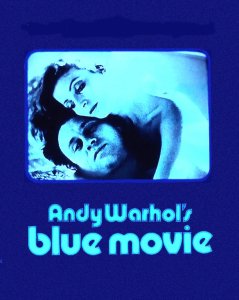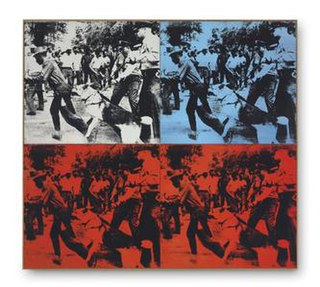Related Research Articles

Andy Warhol was an American visual artist, film director, producer, and leading figure in the pop art movement. His works explore the relationship between artistic expression, advertising, and celebrity culture that flourished by the 1960s, and span a variety of media, including painting, silkscreening, photography, film, and sculpture. Some of his best-known works include the silkscreen paintings Campbell's Soup Cans (1962) and Marilyn Diptych (1962), the experimental films Empire (1964) and Chelsea Girls (1966), and the multimedia events known as the Exploding Plastic Inevitable (1966–67).

Amiga is a family of personal computers introduced by Commodore in 1985. The original model is one of a number of mid-1980s computers with 16- or 16/32-bit processors, 256 KB or more of RAM, mouse-based GUIs, and significantly improved graphics and audio compared to previous 8-bit systems. These systems include the Atari ST—released earlier the same year—as well as the Macintosh and Acorn Archimedes. Based on the Motorola 68000 microprocessor, the Amiga differs from its contemporaries through the inclusion of custom hardware to accelerate graphics and sound, including sprites and a blitter, and a pre-emptive multitasking operating system called AmigaOS.
Computer art is any art in which computers play a role in production or display of the artwork. Such art can be an image, sound, animation, video, CD-ROM, DVD-ROM, video game, website, algorithm, performance or gallery installation. Many traditional disciplines are now integrating digital technologies and, as a result, the lines between traditional works of art and new media works created using computers has been blurred. For instance, an artist may combine traditional painting with algorithm art and other digital techniques. As a result, defining computer art by its end product can thus be difficult. Computer art is bound to change over time since changes in technology and software directly affect what is possible.

The Factory was Andy Warhol's studio in New York City, which had four locations between 1963 and 1987. The Factory became famed for its parties in the 1960s. It was the hip hangout spot for artists, musicians, celebrities and Warhol's superstars. The original Factory was often referred to as the Silver Factory. In the studio, Warhol's workers would make silkscreens and lithographs under his direction.

Christopher Stein is an American musician known as the co-founder and guitarist of the new wave band Blondie. He is also a producer and performer for the classic soundtrack of the hip hop film Wild Style, and writer of the soundtrack for the film Union City, as well as an accomplished photographer.
Laurence Gartel is an American artist, considered a pioneer of digital art. His biography is included in Who's Who, Who's Who in the East, Who's Who in America, Who's Who in American Art, and Who's Who in the World.

Blue Movie is a 1969 American erotic film written, produced and directed by Andy Warhol. It is the first adult erotic film depicting explicit sex to receive wide theatrical release in the United States, and is regarded as a seminal film in the Golden Age of Porn (1969–1984), which, before the legalization of pornography in Denmark on July 1, 1969, started on June 12, 1969 with the release of Blue Movie at the Elgin Theater, and later, the New Andy Warhol Garrick Theatre, in New York City. Blue Movie helped inaugurate the "porno chic" phenomenon, in which porn was publicly discussed by celebrities and taken seriously by film critics, in modern American culture, and shortly thereafter, in many other countries throughout the world. According to Warhol, Blue Movie was a major influence in the making of Last Tango in Paris, an internationally controversial erotic drama film starring Marlon Brando and released a few years after Blue Movie was made. Viva and Louis Waldon, playing themselves, starred in Blue Movie.

Chelsea Girls is a 1966 American experimental underground film directed by Andy Warhol and Paul Morrissey. The film was Warhol's first major commercial success after a long line of avant-garde art films. It was shot at the Hotel Chelsea and other locations in New York City, and follows the lives of several of the young women living there, and stars many of Warhol's superstars. The film is presented in a split screen, accompanied by alternating soundtracks attached to each scene and an alternation between black-and-white and color photography. The original cut runs at just over three hours long.
Maripol is an artist, film producer, fashion designer and stylist. She has had an influence on the looks of influential artists such as Madonna and Grace Jones. As part of the 1980s New York downtown scene, she captured the likes of Jean-Michel Basquiat, Keith Haring, Andy Warhol, and Debbie Harry with her Polaroid camera. Maripol also produced films, most notably Downtown 81.

Campbell's Soup Cans is a work of art produced between November 1961 and June 1962 by American artist Andy Warhol. It consists of thirty-two canvases, each measuring 20 inches (51 cm) in height × 16 inches (41 cm) in width and each consisting of a painting of a Campbell's Soup can—one of each of the canned soup varieties the company offered at the time. The works were Warhol's hand-painted depictions of printed imagery deriving from commercial products and popular culture and belong to the pop art movement.

"Feel the Spin" is a 1985 song by the American vocalist Debbie Harry, featured on the soundtrack album for the film Krush Groove (1985). The song was co-written by Harry and producers John "Jellybean" Benitez and Toni C.. Both producers went on to work with Whitney Houston on her 1988 hit "Love Will Save the Day", from her album Whitney.

Deborah Ann Harry is an American singer, songwriter and actress, best known as the lead vocalist of the band Blondie. Four of her songs with the band reached No. 1 on the US charts between 1979 and 1981.
Andy Warhol directed or produced nearly 150 films. Fifty of the films have been preserved by the Museum of Modern Art. In August 2014, the Museum of Modern Art began a project to digitise films previously unseen and to show them to the public.
Andy Warhol's Fifteen Minutes is an American talk show hosted by artist Andy Warhol, that aired on MTV from 1985 to 1987. One of the network's earliest series, it featured interviews with up-and-coming musicians such as Courtney Love. Other such talk show guests include Debbie Harry and Chris Stein of Blondie, Nick Rhodes of Duran Duran, Ric Ocasek of the Cars, the Ramones, Grace Jones, Yoko Ono, Judd Nelson, Kevin Dillon, John C. McGinley, and William S. Burroughs.

The Andy Warhol Museum is located on the North Shore of Pittsburgh, Pennsylvania, in the United States. It is the largest museum in North America dedicated to a single artist. The museum holds an extensive permanent collection of art and archives from the Pittsburgh-born pop art icon Andy Warhol.

Sarah Urist Green is an American art museum curator, author, and creator and host of PBS Digital Studios program The Art Assignment and Ours Poetica. Green spent seven years curating exhibitions at the Indianapolis Museum of Art, and has freelanced as a curator for other institutions. She is married to author John Green, who serves as an executive producer for The Art Assignment and Ours Poetica.

Race Riot is an 1964 acrylic and silkscreen painting by the American artist Andy Warhol that he executed in 1964. It fetched $62,885,000 at Christie's in New York on 13 May 2014.

Orange Prince(1984) is a painting by American artist Andy Warhol of Prince, the American singer, songwriter, record producer, multi-instrumentalist, actor, and director. The painting is one of twelve silkscreen portraits on canvas of Prince created by Warhol in 1984, based on an original photograph provided to Warhol by Vanity Fair. The photograph was taken by Lynn Goldsmith. These paintings and four additional works on paper are collectively known as the Prince Series. Each painting is unique and can be distinguished by colour.
Ten Portraits of Jews of the Twentieth Century is a 1980 series of ten paintings by Andy Warhol. The series consists of ten silk-screened canvases, each 40 by 40 inches. Five editions of the series were made. The series was also produced by Warhol as a portfolio of screenprints on Lenox museum board comprising editions of 200, 30 Artist Proofs, 5 Printers Proofs, 3 EPs, and 25 unique Trial Proofs.

The Andy Warhol Diaries is an American documentary streaming television limited series from writer, director Andrew Rossi, and executive producer Ryan Murphy, based on the 1989 book of the same name by Andy Warhol, as edited by Pat Hackett. The series simulates the famed pop artist narrating his own diary entries through the use of artificial intelligence technology. Netflix debuted the series of six episodes on March 9, 2022.
References
- ↑ "Launch Of Amiga in US 23.7.1985 - with Andy Warhol and Debbie Harry". YouTube . July 23, 1985. Retrieved January 8, 2024.
- ↑ Staff (November 9, 2006). "Lost Warhol to Premiere at Museum of New Art". Artdaily.